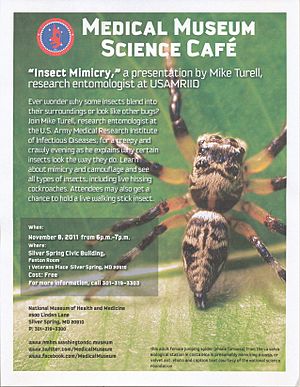National Museum of Health and Medicine facts for kids
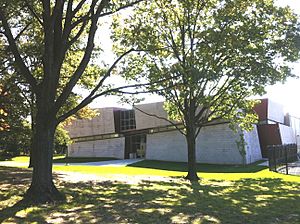
The new NMHM facility,
which opened on September 15, 2011. |
|
| Lua error in Module:Location_map at line 420: attempt to index field 'wikibase' (a nil value). | |
| Established | 1862 (new building, 2011) |
|---|---|
| Location | 2500 Linden Lane, Silver Spring, Maryland |
| Type | Medicine, Military medicine |
| Visitors | 40,000–50,000 annually |
| Public transit access | |
The National Museum of Health and Medicine (NMHM) is a fascinating museum located in Silver Spring, Maryland. It's not far from Washington, D.C.. This museum was first started in 1862 by William A. Hammond, who was the top doctor for the U.S. Army. Back then, it was called the Army Medical Museum (AMM). In 1989, its name changed to NMHM. The museum moved to its current spot at the Army's Forest Glen Annex in 2012. Today, it is part of the Defense Health Agency (DHA).
Contents
History of the Museum
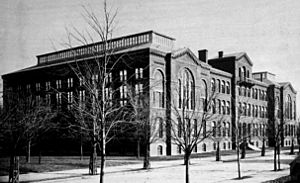
How the Museum Started (19th Century)
The Army Medical Museum (AMM) began during the American Civil War. Its main goal was to collect items for research in military medicine and surgery. In 1862, William Hammond told army doctors to gather "specimens of morbid anatomy." This included things like injured body parts and objects removed from wounds. These items were sent to the new museum for study.
The first person in charge of the AMM was John H. Brinton. He visited battlefields and asked doctors from the Union Army to send in their findings. During and after the war, museum staff took pictures of wounded soldiers. These photos showed how gunshot wounds affected people. They also showed the results of surgeries like amputations. All the information gathered was put into six books. These books were called The Medical and Surgical History of the War of the Rebellion. They were published between 1870 and 1883.
Growing and Changing (20th Century)
In the late 1800s and early 1900s, the AMM staff did a lot of medical research. They were pioneers in taking tiny pictures through microscopes. They also created a library and a system for organizing books. This system later became the basis for the National Library of Medicine (NLM).
The museum also led research into infectious diseases. They even discovered what caused yellow fever. They helped with research on vaccines for typhoid fever. During World War I, AMM staff worked on vaccination programs. They also ran health education campaigns.
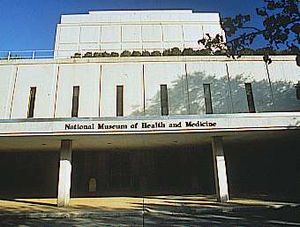
By World War II, the AMM focused more on studying diseases. In 1946, the AMM became part of the new Army Institute of Pathology (AIP). This later became the Armed Forces Institute of Pathology (AFIP) in 1949. The museum's library and some old records went to the National Library of Medicine in 1956.
The museum changed its name several times. It was the Medical Museum of the AFIP in 1949. Then it became the Armed Forces Medical Museum in 1974. Finally, it became the NMHM in 1989. In the 1960s, when it was in a popular location, the museum had many visitors. About 400,000 to 500,000 people came each year. But after moving to less visible places, fewer people visited. By the 1990s, only 40,000 to 50,000 visitors came annually.
Moving to a New Home (2011)
The Walter Reed Army Medical Center was closed down. Because of this, the National Museum of Health and Medicine had to move again. This was its tenth move! It relocated to the Forest Glen Annex in Silver Spring, Maryland.
The museum closed its exhibits on April 3, 2011. It then reopened in a new building on May 14, 2012, at Forest Glen. On October 1, 2015, the NMHM became part of the Defense Health Agency.
What You Can See There
The NMHM has five main collections. These include about 25 million items. You can find 5,000 bone specimens and 8,000 preserved organs. There are also 12,000 pieces of medical equipment. The museum also has old medical documents.
Amazing Collections
The museum's most famous items are related to President Abraham Lincoln. They tell the story of his assassination on April 14, 1865.
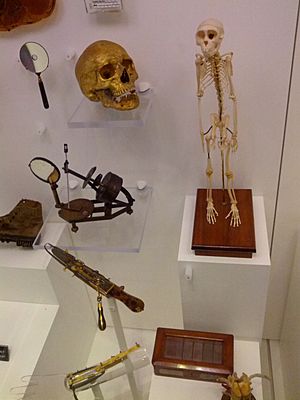
On display, you can see a copy of Lincoln's life mask and hands. These were made in 1860. There is also the bullet that ended his life. You can see the tool used by the Army Surgeon General to find the bullet. Pieces of Lincoln's hair and skull are also there. Even the shirt cuff of the doctor who performed the autopsy, stained with Lincoln's blood, is on display. You can also see a small part of John Wilkes Booth's spine. This was removed after he was shot while trying to escape.
The museum's collections include:
- Historical Collections: These show how medical technology has changed since the early 1800s. There are over 12,000 objects. These include x-ray machines, microscopes, and surgical tools.
- Anatomical Collections: This part has bones and body parts. More than 5,000 bone specimens and 10,000 preserved organs show different diseases and injuries.
- Otis Historical Archives: This section holds photos, drawings, and documents about health and medicine. Over 350 different collections show how medicine was practiced from the Civil War to today.
- Human Developmental Anatomy Center: This center has the largest collection of human embryo materials in the United States. They are known for making 3-D models of how embryos develop.
- Neuroanatomical Collections: These nine collections focus on the brain and nervous system of humans and animals.
Special Exhibitions
The museum has several permanent exhibits and some that change over time.
One notable exhibit is “Trauma Bay II, Balad, Iraq.” This display features a part of an actual emergency room tent. This tent was used in Balad, Iraq, from 2003 to 2007. These military hospitals in Iraq had very high survival rates, over 95%.
Other exhibits include:
- Anatomy and Pathology: These displays show examples of healthy body parts. They help you understand how diseases and injuries change tissues.
- Collection that Teaches: This exhibit shows how the Army Medical Museum collected and shared lessons from Civil War battlefield medicine.
- Abraham Lincoln: The Final Casualty of the War: This exhibit honors President Lincoln. It features items from his last hours and the doctors who cared for him.
- Advances in Military Medicine: These exhibits show how military medicine has improved. Topics include facial reconstruction, surgical responses, and new ways to protect soldiers. It also features "Trauma Bay II, Balad, Iraq." This gives you a look inside a former Air Force hospital tent.
Past exhibits have included:
- To Bind Up the Nation's Wounds: Medicine During the Civil War: This exhibit showed Civil War medicine from the view of battlefield surgeons. It also shared stories of sick and wounded soldiers.
- Evolution of the Microscope: This display traces how microscopes have developed over 400 years.
- Battlefield Surgery 101: From the Civil War to Vietnam: This exhibit used photos and tools from the museum's collections. It showed military surgery over 140 years.
- Resolved: Advances in Forensic Identification of U.S. War Dead: This highlights how science helps identify fallen U.S. service members.
Fun Programs
The museum offers programs for both children and adults. These programs cover medical, scientific, and historical topics.
- Public Programs
- Tours
- Brain Awareness Week
Where to Find It
The museum is located at 2500 Linden Lane in Silver Spring, Maryland. It is about one mile outside of Washington, D.C.. The museum is open from 10 a.m. to 5:30 p.m. Wednesday through Sunday. It is closed on Christmas. Admission is free for everyone.
See also


